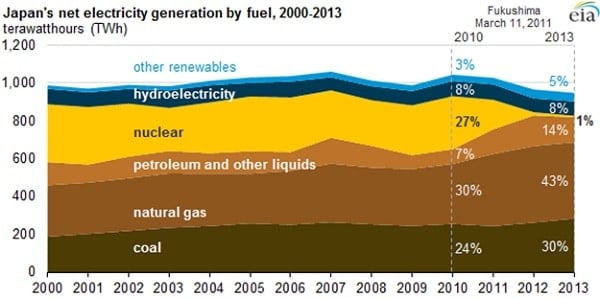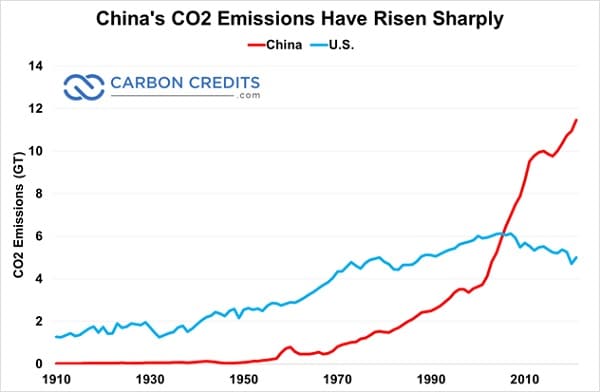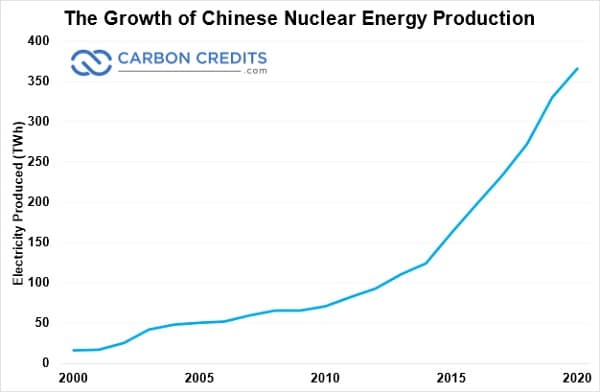A year earlier, Japan had been the world’s third-largest producer of nuclear energy. Nuclear supplied more than a quarter of the nation’s electricity.
Then… nothing. Zero reactors in operation, and not a single kilowatt of energy from nuclear.
It was a knee-jerk reaction to the Fukushima disaster, fully supported by a vast majority of Japanese citizens. And it shot Japan in the foot.
Because it quickly discovered that shutting down nuclear required paying an extra $37 billion a year for imported fossil fuels…
… which led to spiraling electricity prices, extreme government debt, and rising emissions.
In fact, emissions increased 30 percent from 2011 to 2012. And in 2013, Japanese emissions hit an all-time high.
Japan’s climate change goal had been to reduce emissions from electricity production by 25 percent by 2020.
But without nuclear, Japan’s Minister of the Environment was forced to revise that figure… to a 3.1 percent increase.
In early 2021, amidst historic power shortages, Japan’s Energy Minister finally reversed course on the nuclear-free policy. “Nuclear power will be indispensable,” he said.
A new future, indeed.
A year later, the Prime Minister of Japan called for the “maximum use” of nuclear. And he ordered the government to restart idled nuclear plants at an accelerated rate.
Out of Japan’s thirty-three operable nuclear reactors, ten have already been restarted. Sixteen more are slated to be restarted by the end of 2023, and two new reactors will be brought online.
- Not only that, but Japan has begun developing next-generation nuclear reactors.
It’s a momentous policy shift for a country that swore off of nuclear energy just a decade ago.
And it’s a common theme in every country with a major nuclear energy program.
From Japan to Germany to the UK to the U.S., closed nuclear plants are being recommissioned —and those scheduled for closure are remaining open.
But many countries are going even further…
They are transforming from hell-bent on shutting down nuclear to accelerating and even incentivizing the development of new nuclear programs.
Sweden Drinks the Radioactive Kool-Aid
For the last thirty years, Sweden has deliberately created the worst possible environment for nuclear.
In the ‘80s, it made plans to phase out nuclear power generation by 2010.
Then it outright banned nuclear research.
Then it banned restarting closed reactors.
And then it imposed a $0.30/kWh tax on nuclear energy.
In 2006, that tax was doubled… and increased another 25 percent in 2008.
One study put the tax at 60 percent of the operating cost of nuclear reactors in Sweden.
The tax forced two reactors, Ringhals 1 and 2, to close in 2019–2020.
And it was on track to close all three nuclear power plants in Sweden, which provide 30 percent of its electricity.
Vattenfall, a state-owned energy company, said abolishing the tax would decrease its generating costs to $20/MWh by 2021.
In 2022, the average wholesale electricity price in Sweden was $112/MWh.
That’s why 2022 polls showed that 60 percent of the population didn’t just want nuclear to stay—they wanted new reactors to be built.
But the political risk and uncertainty surrounding nuclear investments prevented any company from ever wanting to touch it again.
So when the new government came into power, it released a policy called the “Tidö Agreement.”
The agreement says that nuclear plants must be guaranteed the right to produce carbon-free electricity.
- And if Sweden forces a plant to close, “the owners must be entitled to compensation.”
Then, the government pivoted from taxing nuclear reactors out of existence… to subsidizing them.
The document pledged $40 billion in loan guarantees for nuclear power construction—making it far easier for nuclear developers to get commercial funding.
It also called for:
- A removal of the ban on restarting closed reactors.
- Restarting Ringhals 1 and 2.
- A shorter permit process and a fast track for new nuclear power.
- A highly reduced application fee for new nuclear reactors.
None of this is hypothetical. Vattenfall, the previously mentioned major nuclear power company, has already been asked to identify suitable locations for additional nuclear reactors.
China: First in Emissions, First in Nuclear
Sweden is one of only thirty-three countries that currently produce nuclear energy. Thirty more are considering, planning, or starting their own nuclear energy programs.
Belarus, Bangladesh, and Turkey are all building their first nuclear reactors.
A single reactor coming online in Finland will provide 28 percent of its electricity.
But the real demand won’t come from small or developing nations. In fact, nuclear plants produce too much energy for them; if they are taken offline for refueling or maintenance, it could cause blackouts.
That’s why Slovenia and Croatia literally share a nuclear power plant on their border.
- The real demand for nuclear energy will come from rapidly developing countries with high carbon emissions and huge populations.
That makes China, which has the largest and fastest-growing group of energy-consuming humans in history, the perfect candidate for nuclear.
In 2021, China’s electricity demand jumped 10 percent. For context, that’s equal to the total electricity demand of all of Africa.
Which means emissions are exploding. While every other developed country is trying to cut their emissions, China’s have risen by more than 300 percent in the past twenty years.
Right now, more than a third of global CO2 emissions come from China.
They are building out solar and wind, but their real focus is on nuclear.
Thirty years ago, China had zero nuclear power. In 2002, China was 15th in nuclear production in the world.
- 10th in 2007.
- 3rd in 2016.
- 2nd in 2020.
Fitch analysts now predict that China’s nuclear power capacity will overtake the U.S. by 2026.
Nuclear energy capacity in China is precisely following its emissions trajectory—only about a decade later. Which means it won’t stop when it’s #1 in the world.
In just fifteen years, China plans to build 150 nuclear plants, which is more than the U.S. has built—ever.
CNNC, a Chinese nuclear power company, is urging the government to approve a new nuclear project every two months for the next decade.
China plans to get up to 327 GWe by 2050, or more than three times the United States.
China’s population twin, India, is facing the same problem with growing emission—and seeking the same solution.
India Goes Fleet Mode
For its 1.4 billion people—18 percent of the world’s population—India has a measly 6.8 GW of capacity across seven nuclear plants.
It’s an embarrassing 1.7 percent of the country’s total power generation capacity.
Even so, Prime Minister Modi is intent on scaling up nuclear energy as fast as is humanly possible.
In the past fifteen years, nuclear power generation in India has already risen more than 300 percent.
India’s building another 6.6 GW of capacity right now—the most after China.
It has already approved another 8.4 GW of capacity—twelve more reactors—to begin construction in the next three years.
And it has a staggering 31 GW of nuclear builds planned.
Modi plans to triple nuclear capacity again over the next decade. That’s nearly seventy new reactors coming online.
How big could it really get?
- India plans to supply 25 percent of its electricity from nuclear power by 2050.
That would require 100 GW of nuclear—again, more than the U.S.
To facilitate this, India is setting up five massive “Nuclear Energy Parks,” which can handle 10GW at a single location.
By 2032, five of these parks are planned to potentially provide between 40 and 45 GW of carbon-free energy.
Once it gets going, this is hockey-stick growth.
There’s only one problem: India has very little nuclear technology of its own. For that matter, most developed countries don’t—even those with nuclear reactors.
Only five countries on the planet actually have the skills, materials, and supply chain to build nuclear reactors.
And they are all preparing to wage a full-scale war to be able to deliver the world’s most valuable energy to the rest of the planet.







